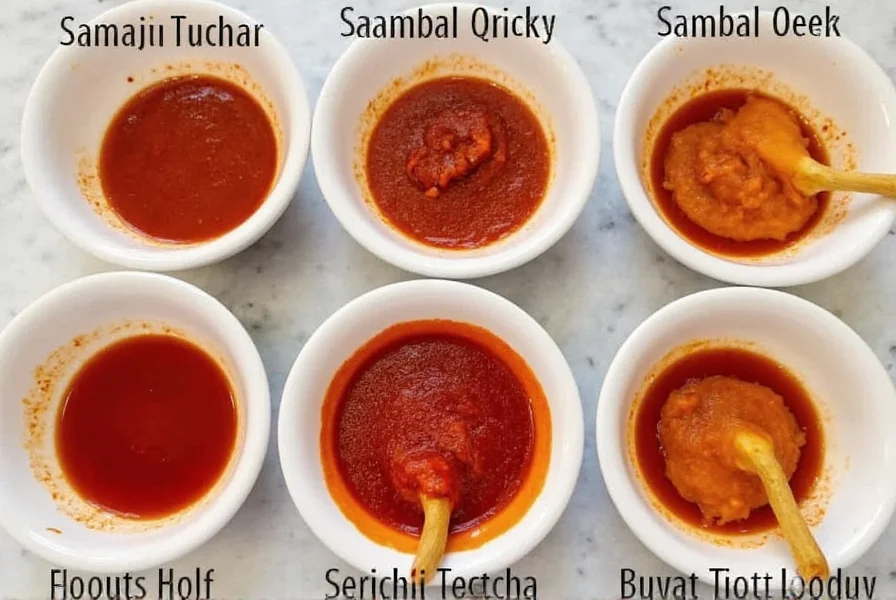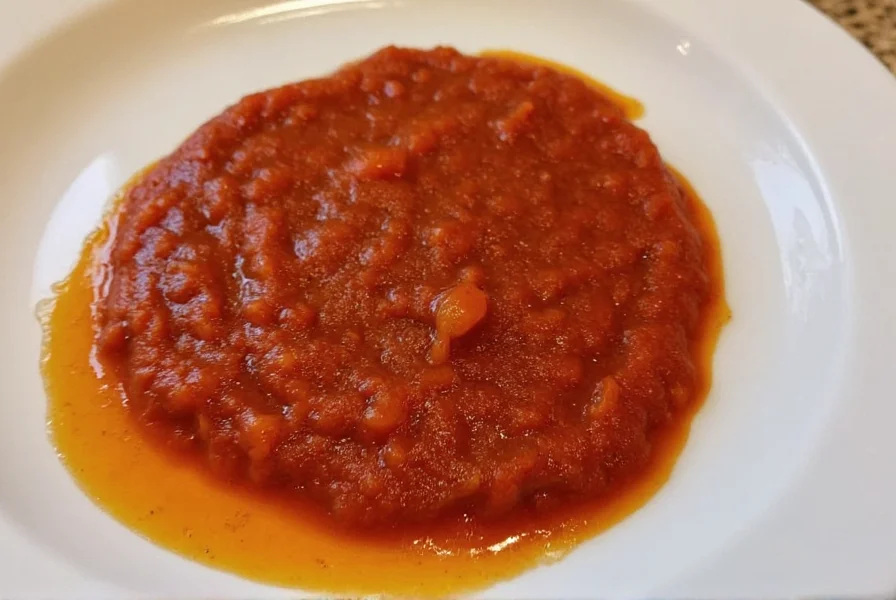When you're in the middle of cooking and realize you're out of chili paste, knowing reliable alternatives can save your recipe. Chili paste—a staple in many Asian, Southeast Asian, and Latin American cuisines—provides heat, depth, and umami that's difficult to replicate exactly. However, several common pantry items can effectively stand in when used correctly.
Understanding Chili Paste Characteristics
Before selecting a substitute, understand what makes chili paste unique. Traditional chili pastes like sambal oelek or Thai chili paste contain ground fresh chilies, vinegar, salt, and sometimes garlic or other aromatics. They offer:
- Medium to high heat level (varies by brand and region)
- Thick, spreadable consistency
- Bright, acidic notes from vinegar
- Subtle sweetness in some varieties
- Complex umami depth
When substituting, consider which elements matter most for your specific dish—heat intensity, texture, or flavor complexity.

Top 6 Practical Chili Paste Substitutes
These alternatives are ranked by effectiveness and availability. Always start with less than the recipe calls for, then adjust to taste.
1. Sambal Oelek (Best Direct Substitute)
This Indonesian chili paste made from ground red chilies, vinegar, and salt most closely matches standard chili paste. Use a 1:1 ratio. Sambal oelek lacks the garlic found in some chili pastes, so add 1 minced garlic clove per tablespoon if your recipe requires that flavor dimension. Ideal for stir-fries, marinades, and dipping sauces.
2. Sriracha (Best for Garlic-Forward Recipes)
While thinner than traditional chili paste, sriracha offers similar heat with added garlic and a touch of sweetness. Use 1:1 but reduce other liquids slightly in your recipe. Perfect for Thai-inspired dishes, noodle bowls, and as a finishing sauce. Note that sriracha contains sugar, which may caramelize differently during cooking.
3. Harissa (Best for North African/Middle Eastern Dishes)
This North African chili paste brings smoky depth from roasted red peppers and spices like cumin and coriander. Use 3/4:1 ratio (3/4 tablespoon harissa per 1 tablespoon chili paste) as it's typically hotter. Excellent in stews, roasted vegetables, or mixed into yogurt for a spicy sauce.
4. Chili Garlic Sauce (Best Texture Match)
Often found in Asian grocery stores, this sauce contains both chilies and garlic in a similar texture to chili paste. Substitute at a 1:1 ratio. The primary difference is slightly higher vinegar content, so reduce other acidic elements in your recipe by 10-15%.
5. Homemade Quick Substitute (Best Pantry Solution)
Mix 1 teaspoon red pepper flakes + 1 teaspoon tomato paste + 1 teaspoon rice vinegar + 1/2 teaspoon garlic powder. Let sit for 10 minutes to allow flavors to meld. Use 1:1 ratio. This solution works well when you need immediate heat without specialty ingredients.
6. Gochujang (Best for Korean-Inspired Dishes)
This fermented Korean chili paste offers deep umami but is sweeter and thicker than standard chili paste. Dilute 1 part gochujang with 1 part water or broth before using at a 1:1 ratio. Ideal for braises, glazes, and marinades where complexity matters more than pure heat.
| Substitute | Heat Level | Flavor Profile | Best Used In | Conversion Ratio |
|---|---|---|---|---|
| Sambal Oelek | Moderate-High | Clean chili heat, minimal additives | Stir-fries, marinades, dipping sauces | 1:1 |
| Sriracha | Moderate | Garlicky, slightly sweet | Noodle dishes, finishing sauces | 1:1 (reduce liquids) |
| Harissa | High | Smoky, complex spices | Stews, roasted vegetables | 3:4 |
| Chili Garlic Sauce | Moderate | Garlicky chili flavor | Asian-inspired dishes | 1:1 |
| Homemade Mix | Adjustable | Basic chili heat | Emergency substitutions | 1:1 |
| Gochujang | Moderate | Sweet, fermented umami | Korean-inspired dishes | 1:1 (diluted) |
Adjusting Recipes When Substituting
Successful substitution requires more than a simple ingredient swap. Consider these adjustments:
- Liquid content: Thinner substitutes like sriracha may require reducing other liquids by 10-15% to maintain proper consistency
- Acidity balance: If your substitute contains vinegar (most do), reduce other acidic elements like lime juice or additional vinegar
- Sweetness compensation: Gochujang and sriracha contain sugar—reduce added sweeteners accordingly
- Flavor development: Add garlic or ginger separately if your substitute lacks these elements
- Heat adjustment: Always start with 75% of the recommended amount, then taste and increase as needed
Cuisine-Specific Substitution Guidance
Different culinary traditions use chili paste in distinctive ways. Tailor your substitute to match the cuisine:
- Thai cooking: Use sambal oelek with added lime juice (1/2 teaspoon per tablespoon) for authentic flavor in curries and pad thai
- Chinese cooking: Opt for chili garlic sauce or a mix of doubanjiang (fermented bean paste) and cayenne for mapo tofu and similar dishes
- Mexican cooking: Try chipotle in adobo sauce (blended smooth) for mole or adobo recipes requiring smoky heat
- Korean cooking: Gochujang (diluted) works best for bibimbap sauce or tteokbokki, though it won't replicate all nuances
When Substitution Won't Work
Some recipes rely so heavily on chili paste's specific properties that substitutes fall short:
- Fermented dishes where chili paste contributes to the fermentation process
- Recipes where texture is critical, like certain dipping sauces that require chili paste's specific viscosity
- Dishes where chili paste is the primary flavor component rather than a supporting ingredient
In these cases, consider modifying your recipe rather than forcing a substitution.
Storage Tips for Substitutes
Most chili paste alternatives maintain quality for 2-4 weeks when stored properly:
- Refrigerate all opened chili-based products in airtight containers
- Label containers with date of opening
- Freeze small portions in ice cube trays for longer storage (up to 3 months)
- Stir well before each use as separation is normal
Frequently Asked Questions
Can I use hot sauce instead of chili paste?
Yes, but with adjustments. Most liquid hot sauces (like Tabasco) are too thin and vinegary. Use 2 parts hot sauce to 1 part tomato paste to thicken, and reduce other liquids in your recipe. For every tablespoon of chili paste, use 1.5 teaspoons of this mixture.
What's the difference between chili paste and chili powder?
Chili paste is a wet ingredient made from ground fresh chilies with vinegar and other ingredients, while chili powder is dried and ground. To substitute chili powder for paste, mix 1 teaspoon chili powder with 1 teaspoon water, 1/2 teaspoon vinegar, and 1/4 teaspoon oil. Let sit for 10 minutes before using.
How do I adjust heat levels when substituting chili paste?
Start with 75% of the recommended substitute amount, then taste and adjust. Remove seeds from fresh chilies when making homemade substitutes for milder heat. For hotter results, add a pinch of cayenne pepper to your substitute mixture. Remember that heat perception increases as dishes cook, so better to under-season initially.
Can I make chili paste from dried chilies?
Yes. Soak 1/4 cup dried chilies in hot water for 20 minutes until soft. Drain, then blend with 2 tablespoons vinegar, 1 tablespoon oil, 1 clove garlic, and 1/2 teaspoon salt until smooth. This creates approximately 1/2 cup of chili paste. Adjust liquid for desired consistency.











 浙公网安备
33010002000092号
浙公网安备
33010002000092号 浙B2-20120091-4
浙B2-20120091-4